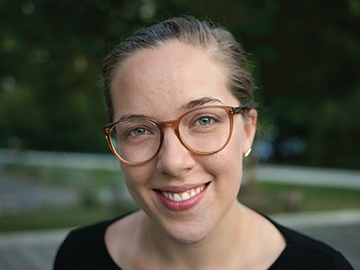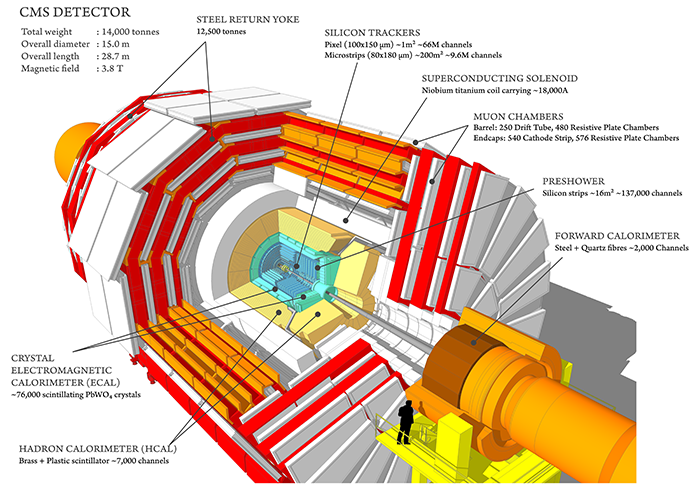Finding Hidden Physics
June 7, 2022
Tova Holmes has a challenging but welcome task: looking for hidden physics with particles no human can see. She’ll pursue this aim with an Early Career Research award from the US Department of Energy Office of Science. The grant begins July 1 and includes $750,000 of support over the next five years.

Tova Holmes
Particle physics helps drive not only discoveries about our universe but also innovative tools that improve our lives here on earth. As a field it describes the stuff of matter but it's also the foundation for practical spinoffs like Wi-Fi and magnetic resonance imaging (MRIs). Holmes joined the department as an assistant professor in 2020 and is part of the CMS group, which uses the Compact Muon Solenoid detector to study high-energy particle collisions in the search for new particles, and new physics, at the Large Hadron Collider (LHC) in Geneva.
The LHC is where scientists discovered the Higgs boson, a feat that led to a Nobel Prize and completed the Standard Model of physics. All matter in the universe is made of fundamental particles and forces and the Standard Model explains how they relate to one another. The Higgs has a crucial role in this framework.
"When we designed the LHC, we wanted to find the Higgs," Holmes explained. "There's a Higgs field everywhere and it contains energy everywhere. All of our other particles are basically continuously interacting with this Higgs field as they move through space. That mechanism is exactly what gives most of the particles in the Standard Model mass."
The Higgs may be a giver, but it's also a taker.
"There's a key problem that only gets worse when you find the Higgs, which is that the Higgs mass itself doesn't make any sense," Holmes said. "(It) not only gives mass to those other particles, it's going to collect additional mass from the interactions. That means that its mass should blow up. You're solving one mass problem by introducing the Higgs, but you're creating a new one."
This problem fuels the idea that there's something else that so far has escaped detection.
"We can tell that we're missing things," Holmes said. "There's direct evidence that we have missed something that could be as big as the Standard Model itself. We might be looking at a tiny corner of what actually exists out there."
Finding something new would in effect break the Standard Model, and that's where Holmes' research comes in.
"I am studying things that would couple to the Higgs and solve this mass problem," she said.
Her proposal will upgrade detector capabilities and take new data that can identify phenomena the LHC might have previously missed, including long-lived particles.
These particles Holmes hopes to find have unconventional signatures, which she describes as "things that our detectors weren’t designed to look for."
The CMS detector sits on one of four collision points on the LHC ring, the most powerful particle accelerator ever built. Though CMS is described as a giant, high-speed camera, "we never directly see any of the particles that we study," Holmes said. "That’s the inherent challenge."
The detector does the looking instead.
The CMS detector resembles a giant cylinder with several layers wrapped around it. Collisions occur in the center. Exotic, unstable particles like the Higgs decay almost immediately, while more commonplace particles like electrons and muons have longer trajectories and filter through more layers. As they travel, the detector measures what they leave behind (electric charge, energy, etc.) as a way to identify them. The detector’s design limits what it can measure, but it’s not the only restriction.
"Not only our detector, but also our trigger system," Holmes said, "which is how we decide while we’re running our experiment which of the data to keep. We collide 40 million times a second and we keep about a thousand of those collisions per second. If our trigger isn’t designed for a signature, then it’s something we would have missed."

CMS Detector, courtesy of CERN
Longer-lived particles—the ones that make it through more layers before they decay—leave the unconventional signatures she wants to find. They can show up in supersymmetry (SUSY), which Holmes described as "a whole zoo of particles that exist, one for each of the Standard Model particles." Every particle would have a partner that’s its opposite, balancing things out. Finding SUSY, she said, "magically solves all your problems."
With the DOE grant her group will expand the detector’s triggering capabilities to record new data that she hopes will reveal a wider variety of long-lived particles, including those that might show up in SUSY. Students and postdocs will play a key role, Holmes said, as "every major physics output will be driven by a graduate student."
Beyond the research and educational aspects, why does this research matter? It has to do both with the fate of our planet and how well we live on it.
"We might find as we understand the Higgs better that we’re actually in an unstable point of the Higgs vacuum, which is to say at any point our universe could tunnel to a new state and explode, or collapse into a tiny nothing," Holmes explained. "We don’t fundamentally understand where our universe is going. Understanding the Higgs is really key to that."
(She emphasizes she doesn’t expect this to happen anytime soon.)
"From a much more practical point of view, we have a long history of finding fundamental particles and not knowing why anyone would care, and then finding out there are really good reasons," she said.
When electromagnetic radiation was discovered people thought it was a nice, if useless, idea. Now we know it’s the foundation of Wi-Fi, infrared and X-rays, among other applications. The same goes for MRIs. To build the former Tevatron particle accelerator at Fermilab required bending beams with magnets.
"In developing that magnet technology, they made the first large-scale production of these really high-field magnets that are now the magnets that are used in MRIs," Holmes explained. "It was particle physics that created that technology. That’s the nature of trying to do technical accomplishments that have never been achieved before: you build technology that gets used by everybody else. Basically everything that we have technology-wise today was built on fundamental discoveries."
"That’s the nature of trying to do technical accomplishments that have never been achieved before: you build technology that gets used by everybody else. Basically everything that we have technology-wise today was built on fundamental discoveries."
Pursuing these fundamental discoveries is a good fit for the Early Career Research Program, which made 83 awards this cycle (Livia Casali of the UT Department of Nuclear Engineering was also among the awardees). The initiative supports outstanding scientists early in their careers whose research reinforces the DOE Office of Science mission to deliver scientific discoveries and tools to transform our understanding of nature and advance the energy, economic, and national security of the United States.
For Holmes that means keeping an eye on where particle physics should go next. While the LHC has been wildly successful, she believes future particle accelerators will require some new thinking.
"We went from tiny, tabletop rings to bigger ones that are the size of a building," she said. "Then we went to where it fits, just barely, in the laboratory site. Now we’re at the LHC where it literally goes across countries’ borders."
Building bigger rings can only take you so far, she said, adding that "if we want our field to continue, we need alternative paths."
Her team has been working on a muon collider to solve some of these problems. It’s a circular collider where the ring size is related to the mass of the particle you’re accelerating. There are some hurdles, like trying to get a beam out of unstable particles, but Holmes is undeterred by those obstacles.
"That creates some interesting experimental challenges," she said. "But those are problems you can solve—not impossibilities."